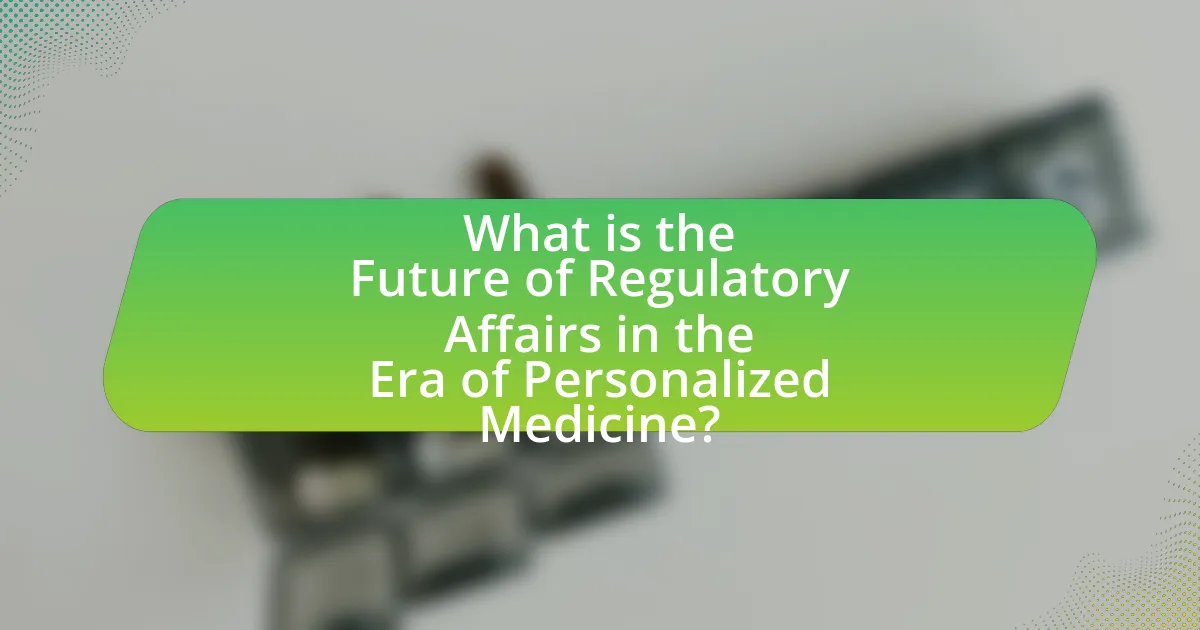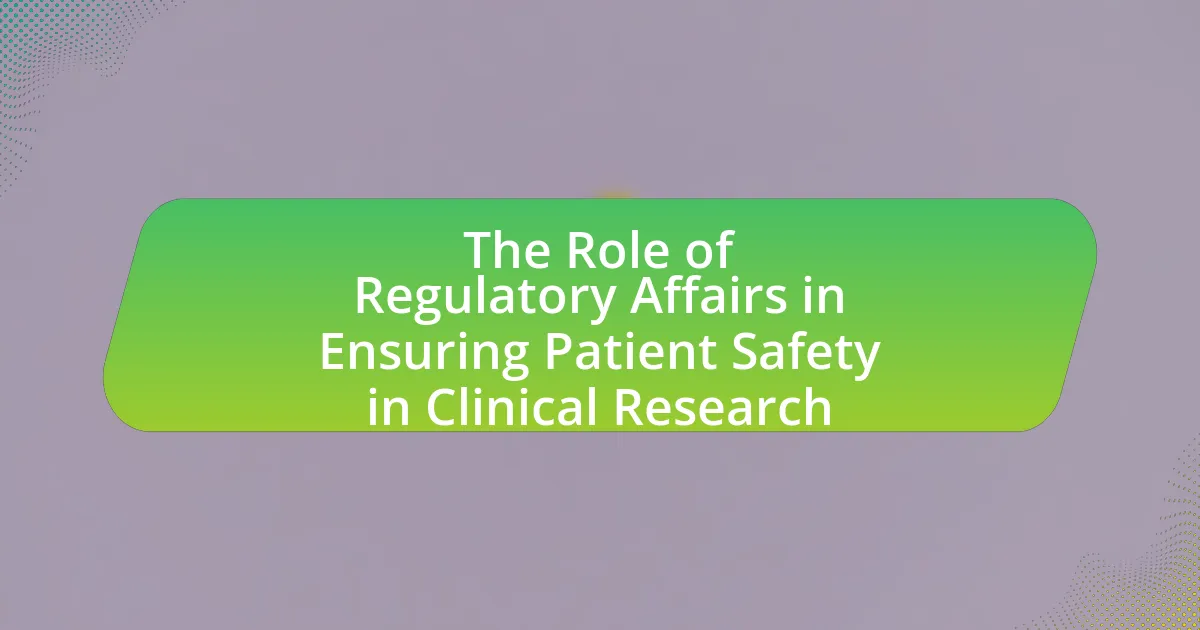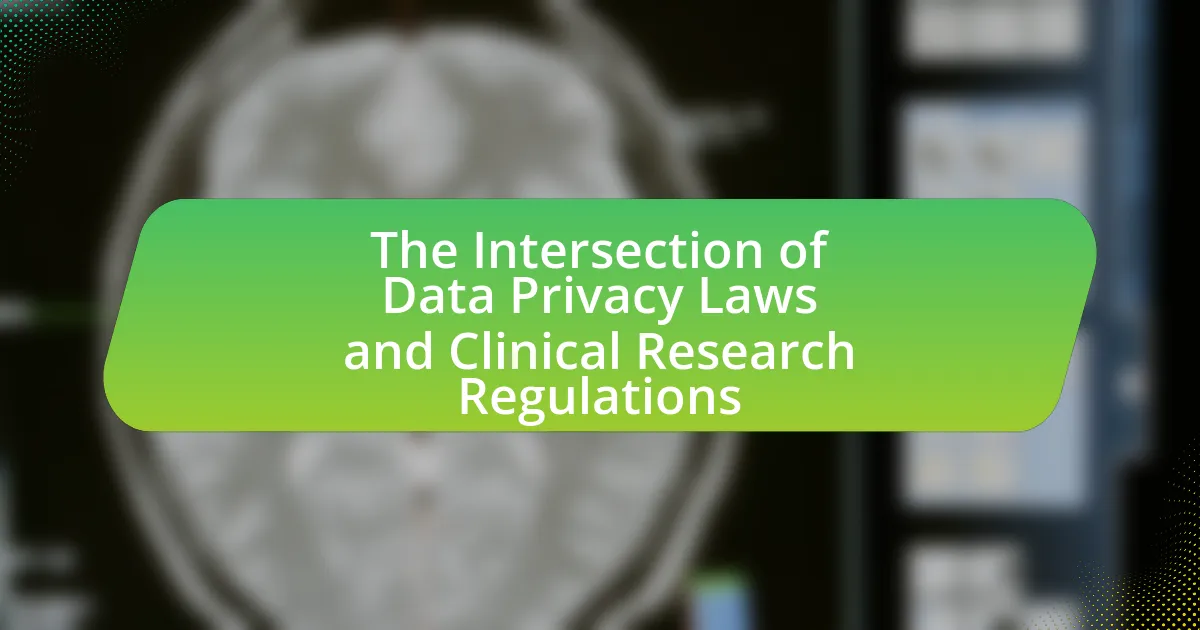The article focuses on the future of regulatory affairs in the context of personalized medicine, emphasizing the need for adaptive regulatory frameworks that accommodate individualized therapies. It discusses how regulatory bodies, such as the FDA and EMA, are evolving their guidelines to facilitate the approval of targeted therapies based on genetic and biomarker data. Key topics include the challenges faced by regulatory affairs, ethical considerations, the impact of data privacy, and the opportunities for collaboration among stakeholders. The article also highlights best practices for navigating regulatory changes and the implications for pharmaceutical companies, healthcare providers, and patients in the rapidly advancing field of personalized medicine.

What is the Future of Regulatory Affairs in the Era of Personalized Medicine?
The future of regulatory affairs in the era of personalized medicine will increasingly focus on adaptive regulatory frameworks that accommodate the unique characteristics of individualized therapies. As personalized medicine advances, regulatory bodies like the FDA and EMA are expected to implement more flexible guidelines that facilitate the rapid approval of targeted therapies based on genetic and biomarker data. For instance, the FDA’s Breakthrough Therapy designation has already streamlined the approval process for drugs that treat serious conditions and fill an unmet medical need, reflecting a shift towards more responsive regulatory practices. This evolution is necessary to keep pace with the rapid development of innovative treatments and to ensure patient safety while promoting timely access to effective therapies.
How is personalized medicine changing the landscape of regulatory affairs?
Personalized medicine is transforming regulatory affairs by necessitating adaptive frameworks that accommodate individualized treatment approaches. Traditional regulatory processes, which often rely on a one-size-fits-all model, are being challenged as personalized therapies require more nuanced evaluation criteria. For instance, the FDA has introduced the concept of “real-world evidence” to support the approval of personalized therapies, reflecting a shift towards data that captures the effectiveness of treatments in diverse patient populations. This evolution is underscored by the increasing number of targeted therapies approved, such as those for specific genetic mutations in cancer, which demand regulatory bodies to develop guidelines that address the complexities of biomarker-driven treatments.
What are the key characteristics of personalized medicine that impact regulation?
Personalized medicine is characterized by its focus on tailoring medical treatment to individual patient characteristics, which significantly impacts regulation. This approach necessitates the integration of genetic, biomarker, and phenotypic data into clinical decision-making, leading to the need for regulatory frameworks that can accommodate the complexity of these individualized therapies. For instance, the U.S. Food and Drug Administration (FDA) has established guidelines for the approval of companion diagnostics, which are tests that help determine the suitability of a specific treatment for a patient based on their genetic profile. This regulatory shift reflects the need for adaptive pathways that can respond to the rapid advancements in genomics and biotechnology, ensuring that safety and efficacy are maintained while fostering innovation. Additionally, the variability in patient responses to treatments underscores the importance of post-market surveillance and real-world evidence in regulatory assessments, as these factors can influence the ongoing evaluation of personalized therapies.
How do regulatory frameworks adapt to innovations in personalized medicine?
Regulatory frameworks adapt to innovations in personalized medicine by implementing flexible guidelines that accommodate rapid advancements in technology and scientific understanding. For instance, agencies like the FDA have introduced initiatives such as the Breakthrough Devices Program, which expedites the approval process for innovative medical devices that provide significant benefits over existing options. This program reflects the need for regulatory bodies to be responsive to the unique challenges posed by personalized medicine, such as the integration of genetic data and tailored therapies. Furthermore, the FDA’s guidance documents on the use of real-world evidence in clinical trials illustrate how regulatory frameworks are evolving to incorporate new methodologies that enhance the evaluation of personalized treatments. These adaptations ensure that regulations remain relevant and effective in overseeing the safety and efficacy of personalized medical innovations.
What challenges do regulatory affairs face in the context of personalized medicine?
Regulatory affairs face significant challenges in the context of personalized medicine, primarily due to the complexity of developing and approving therapies tailored to individual genetic profiles. The variability in patient responses to treatments necessitates a more nuanced regulatory framework that can accommodate diverse clinical data and evidence. For instance, traditional clinical trial designs may not be suitable for personalized therapies, which often require adaptive trial designs to assess efficacy across different patient subgroups. Additionally, the rapid pace of innovation in genomic technologies outstrips existing regulatory guidelines, leading to potential delays in approval processes. The need for collaboration between regulatory bodies, healthcare providers, and pharmaceutical companies is critical to address these challenges effectively.
What are the ethical considerations in regulating personalized medicine?
The ethical considerations in regulating personalized medicine include issues of informed consent, data privacy, equity in access, and the potential for discrimination. Informed consent is crucial as patients must understand how their genetic information will be used, which is supported by the principle of autonomy in medical ethics. Data privacy concerns arise from the sensitive nature of genetic data, necessitating robust protections to prevent misuse, as highlighted by regulations like the Health Insurance Portability and Accountability Act (HIPAA). Equity in access addresses the risk that personalized medicine may exacerbate health disparities, emphasizing the need for regulations that ensure all populations benefit equally. Lastly, the potential for discrimination based on genetic information raises ethical concerns, prompting calls for laws that protect individuals from genetic discrimination, such as the Genetic Information Nondiscrimination Act (GINA) in the United States. These considerations are essential for developing a regulatory framework that safeguards patient rights while promoting innovation in personalized medicine.
How do data privacy and security issues affect regulatory practices?
Data privacy and security issues significantly influence regulatory practices by necessitating stricter compliance measures and frameworks. Regulatory bodies, such as the European Data Protection Board, have implemented regulations like the General Data Protection Regulation (GDPR) to address these concerns, mandating organizations to enhance their data protection protocols. This shift towards stringent regulations is evidenced by the increase in fines for non-compliance, which reached over €1.5 billion in 2020 alone under GDPR. Consequently, organizations must adapt their operational practices to ensure data security, impacting how they conduct clinical trials and manage patient information in personalized medicine.
What opportunities arise for regulatory affairs in the era of personalized medicine?
Regulatory affairs in the era of personalized medicine present opportunities for enhanced collaboration between regulatory bodies and pharmaceutical companies to streamline the approval process for targeted therapies. This collaboration is essential as personalized medicine often involves complex data sets and innovative technologies, requiring regulators to adapt their frameworks to accommodate these advancements. For instance, the FDA has established the Breakthrough Therapy designation, which expedites the development and review of drugs that treat serious conditions and fill an unmet medical need, thereby facilitating faster access to personalized treatments. Additionally, the rise of real-world evidence in regulatory submissions allows for more flexible evaluation of treatment efficacy, further supporting the integration of personalized medicine into clinical practice.
How can regulatory bodies foster innovation in personalized medicine?
Regulatory bodies can foster innovation in personalized medicine by implementing adaptive regulatory frameworks that allow for flexible approval processes. These frameworks enable quicker access to novel therapies by accommodating the unique characteristics of personalized medicine, such as the use of biomarkers and genetic information. For instance, the FDA’s Breakthrough Therapy Designation expedites the development and review of drugs that treat serious conditions and fill an unmet medical need, which has been instrumental in advancing personalized treatments. Additionally, regulatory bodies can promote collaboration between stakeholders, including researchers, healthcare providers, and industry, to facilitate knowledge sharing and streamline the development process. This collaborative approach has been shown to enhance innovation, as evidenced by initiatives like the FDA’s Patient-Focused Drug Development program, which incorporates patient perspectives into the regulatory process.
What role do collaborations between stakeholders play in regulatory advancements?
Collaborations between stakeholders play a crucial role in regulatory advancements by fostering communication, sharing expertise, and aligning interests among diverse parties such as government agencies, industry leaders, and patient advocacy groups. These collaborations enable the development of more effective and adaptive regulatory frameworks that can keep pace with innovations in personalized medicine. For instance, the FDA’s Patient-Focused Drug Development initiative exemplifies how stakeholder engagement can lead to more relevant regulatory guidelines that reflect patient needs and experiences, ultimately enhancing the approval process for new therapies.
How do regulatory agencies prepare for the future of personalized medicine?
Regulatory agencies prepare for the future of personalized medicine by developing adaptive regulatory frameworks that accommodate innovative therapies and technologies. These agencies, such as the FDA and EMA, are actively engaging with stakeholders, including industry leaders and researchers, to understand the complexities of personalized medicine. For instance, the FDA has established the Precision Medicine Initiative, which aims to enhance the regulatory process for targeted therapies by incorporating real-world evidence and biomarker-driven approaches. This initiative reflects a commitment to evolving regulatory standards that support the rapid advancement of personalized treatments while ensuring patient safety and efficacy.
What strategies can be implemented to enhance regulatory efficiency?
Implementing streamlined processes, such as risk-based assessments and adaptive regulatory pathways, can significantly enhance regulatory efficiency. Risk-based assessments prioritize resources on higher-risk products, allowing regulators to focus on critical areas while expediting the review of lower-risk items. Adaptive regulatory pathways, which allow for iterative feedback and real-time adjustments during the development process, facilitate quicker approvals and foster innovation. For instance, the FDA’s Breakthrough Therapy designation has demonstrated success in accelerating the development of therapies for serious conditions, reducing review times significantly compared to traditional pathways. These strategies not only improve the speed of regulatory processes but also ensure that safety and efficacy standards are maintained.

What are the implications of regulatory changes for stakeholders in personalized medicine?
Regulatory changes in personalized medicine significantly impact stakeholders, including pharmaceutical companies, healthcare providers, and patients. These changes can lead to accelerated drug approvals and increased market access for innovative therapies, as seen with the FDA’s 21st Century Cures Act, which aims to streamline the regulatory process for personalized treatments. Additionally, stakeholders may face new compliance requirements and data management challenges, particularly concerning patient privacy and genetic information, as regulations evolve to address ethical considerations. The shift towards value-based care models also necessitates that stakeholders adapt to demonstrate the effectiveness and cost-efficiency of personalized therapies, influencing reimbursement strategies and market dynamics.
How do changes in regulation affect pharmaceutical companies?
Changes in regulation significantly impact pharmaceutical companies by altering their operational frameworks, compliance costs, and market access strategies. For instance, stricter regulations can lead to increased costs for research and development, as companies must invest more in compliance and safety measures. According to a study by the Tufts Center for the Study of Drug Development, the average cost to develop a new drug has risen to approximately $2.6 billion, partly due to regulatory requirements. Additionally, changes in regulations can affect the speed at which new drugs reach the market; for example, expedited approval processes for personalized medicine can enhance market access but require companies to adapt quickly to new guidelines. Thus, regulatory changes directly influence the financial and strategic decisions of pharmaceutical companies.
What adjustments must companies make to comply with new regulations?
Companies must enhance their compliance frameworks to align with new regulations in personalized medicine. This involves updating internal policies, training staff on regulatory requirements, and implementing robust data management systems to ensure patient privacy and data security. For instance, the introduction of the General Data Protection Regulation (GDPR) in Europe necessitated companies to adopt stricter data handling practices, which included obtaining explicit consent from patients for data usage. Additionally, companies must engage in continuous monitoring of regulatory changes and adapt their operational processes accordingly to mitigate risks and ensure adherence to evolving standards.
How can companies leverage regulatory changes to their advantage?
Companies can leverage regulatory changes to their advantage by adapting their strategies to align with new compliance requirements, thereby gaining a competitive edge. For instance, when regulations shift towards personalized medicine, companies can invest in research and development to create tailored therapies that meet these new standards, positioning themselves as leaders in innovation. Historical data shows that companies that proactively adjust to regulatory changes, such as the FDA’s accelerated approval pathways for personalized treatments, often experience increased market share and improved patient outcomes. This strategic alignment not only enhances their reputation but also opens up new revenue streams in emerging markets.
What impact do regulatory changes have on healthcare providers?
Regulatory changes significantly impact healthcare providers by altering operational protocols, compliance requirements, and financial structures. For instance, the implementation of the Affordable Care Act in the United States mandated that healthcare providers adopt electronic health records, which transformed patient data management and billing processes. Additionally, changes in reimbursement policies, such as the shift from fee-for-service to value-based care, compel providers to focus on patient outcomes rather than service volume, thereby influencing clinical practices and resource allocation. These regulatory shifts can also lead to increased administrative burdens and costs, as providers must adapt to new guidelines and reporting standards.
How can providers stay informed about evolving regulations?
Providers can stay informed about evolving regulations by subscribing to industry newsletters, attending relevant conferences, and participating in professional organizations. These resources offer timely updates on regulatory changes and best practices. For instance, organizations like the Regulatory Affairs Professionals Society (RAPS) provide access to regulatory news and educational resources, ensuring that providers remain compliant with the latest standards. Additionally, engaging with regulatory agencies through public comment periods and consultations can offer insights into upcoming changes, further enhancing providers’ understanding of the regulatory landscape.
What training or resources are necessary for compliance?
Compliance in the context of regulatory affairs, particularly in personalized medicine, necessitates specialized training and resources such as regulatory guidelines, industry standards, and ongoing education programs. Regulatory guidelines, including those from the FDA and EMA, provide essential frameworks for compliance, while industry standards like ISO 13485 offer quality management systems relevant to medical devices. Additionally, ongoing education programs, such as workshops and certifications in Good Clinical Practice (GCP) and Good Manufacturing Practice (GMP), are crucial for keeping professionals updated on evolving regulations. These resources ensure that stakeholders are equipped with the knowledge and skills necessary to navigate the complexities of compliance in personalized medicine.
How do patients benefit from advancements in regulatory affairs related to personalized medicine?
Patients benefit from advancements in regulatory affairs related to personalized medicine through improved access to tailored therapies that are more effective and safer for their specific genetic profiles. Regulatory advancements streamline the approval processes for personalized treatments, allowing for quicker market entry of innovative therapies that address individual patient needs. For instance, the FDA’s Breakthrough Therapy designation expedites the development and review of drugs that treat serious conditions and fill an unmet medical need, which has led to faster access to personalized treatments for patients. This regulatory support enhances the overall quality of care by ensuring that therapies are not only scientifically validated but also aligned with the unique characteristics of patient populations, ultimately leading to better health outcomes.
What role does patient advocacy play in shaping regulatory policies?
Patient advocacy plays a crucial role in shaping regulatory policies by ensuring that the perspectives and needs of patients are integrated into the decision-making processes of regulatory bodies. Advocacy groups actively engage with regulators to provide insights on patient experiences, treatment outcomes, and the importance of access to innovative therapies. For instance, organizations like the Patient-Centered Outcomes Research Institute (PCORI) have been instrumental in promoting research that reflects patient priorities, influencing regulatory frameworks to prioritize patient-centric approaches. This engagement leads to more informed policies that align with the actual needs of patients, ultimately enhancing the effectiveness and relevance of regulatory decisions in the context of personalized medicine.
How can patients ensure their rights are protected in personalized medicine?
Patients can ensure their rights are protected in personalized medicine by actively engaging in informed consent processes and understanding their treatment options. Informed consent requires that patients receive comprehensive information about the risks, benefits, and alternatives to personalized treatments, allowing them to make educated decisions regarding their healthcare. Additionally, patients should advocate for transparency in how their genetic and health data will be used, as regulations like the Health Insurance Portability and Accountability Act (HIPAA) in the United States provide legal protections for patient information. By being proactive in these areas, patients can safeguard their rights and ensure that their preferences and privacy are respected in the evolving landscape of personalized medicine.

What are the best practices for navigating regulatory affairs in personalized medicine?
The best practices for navigating regulatory affairs in personalized medicine include early engagement with regulatory agencies, understanding the specific regulatory pathways for personalized therapies, and ensuring robust data collection and analysis. Early engagement allows developers to align their product development with regulatory expectations, which is crucial given the complexity of personalized medicine. Understanding regulatory pathways, such as the FDA’s Breakthrough Therapy designation, can expedite the approval process for innovative treatments. Additionally, robust data collection, including real-world evidence and clinical trial data, supports the safety and efficacy claims necessary for regulatory approval. These practices are essential as personalized medicine continues to evolve, requiring adaptive regulatory frameworks that can accommodate novel therapeutic approaches.
How can stakeholders effectively engage with regulatory agencies?
Stakeholders can effectively engage with regulatory agencies by establishing clear communication channels and providing relevant data to support their positions. This engagement involves regular meetings, participation in public consultations, and submission of well-researched comments on proposed regulations. For instance, the FDA encourages stakeholder input through initiatives like the Patient Engagement Advisory Committee, which allows stakeholders to share their perspectives on regulatory processes. Engaging in these structured dialogues not only fosters transparency but also helps regulatory agencies understand the practical implications of their policies, ultimately leading to more informed decision-making.
What communication strategies enhance collaboration with regulators?
Effective communication strategies that enhance collaboration with regulators include transparency, proactive engagement, and tailored messaging. Transparency fosters trust by providing regulators with clear and comprehensive information about processes and decisions, which is crucial in the complex landscape of personalized medicine. Proactive engagement involves initiating discussions early in the development process, allowing for feedback and adjustments that align with regulatory expectations. Tailored messaging ensures that communication is relevant and understandable, addressing the specific concerns and interests of regulators. These strategies are supported by studies indicating that organizations that prioritize open dialogue and early collaboration with regulatory bodies experience smoother approval processes and better compliance outcomes.
How can stakeholders provide feedback to influence regulatory processes?
Stakeholders can provide feedback to influence regulatory processes by actively participating in public consultations and submitting comments during the rule-making phases. Regulatory agencies, such as the FDA, often seek input from stakeholders, including healthcare professionals, patients, and industry representatives, to gather diverse perspectives on proposed regulations. For instance, the FDA’s Patient Engagement Advisory Committee allows stakeholders to voice their opinions on how regulations impact patient care, thereby shaping the regulatory landscape. This feedback mechanism is crucial as it ensures that regulations are informed by real-world experiences and needs, ultimately leading to more effective and relevant regulatory frameworks in personalized medicine.
What resources are available for staying updated on regulatory changes?
Key resources for staying updated on regulatory changes include government websites, industry associations, and specialized news outlets. Government websites, such as the U.S. Food and Drug Administration (FDA) and the European Medicines Agency (EMA), provide official updates on regulations and guidelines. Industry associations like the Regulatory Affairs Professionals Society (RAPS) offer newsletters, webinars, and conferences focused on regulatory developments. Additionally, specialized news outlets such as Regulatory Focus and FierceBiotech report on the latest changes and trends in regulatory affairs. These resources collectively ensure that professionals in the field remain informed about evolving regulations, which is crucial in the context of personalized medicine.
Which organizations provide guidance on regulatory affairs in personalized medicine?
Organizations that provide guidance on regulatory affairs in personalized medicine include the U.S. Food and Drug Administration (FDA), the European Medicines Agency (EMA), and the International Society for Pharmacoeconomics and Outcomes Research (ISPOR). The FDA offers regulatory frameworks and guidelines specifically tailored for personalized medicine, such as the Precision Medicine Initiative. The EMA similarly provides guidance documents that address the unique challenges of personalized therapies in Europe. ISPOR contributes by focusing on health economics and outcomes research, which are critical for assessing the value of personalized medicine interventions.
How can stakeholders utilize technology to track regulatory developments?
Stakeholders can utilize technology to track regulatory developments by employing advanced data analytics tools and regulatory intelligence platforms. These technologies aggregate and analyze vast amounts of regulatory data from various sources, including government websites, industry publications, and legal databases, enabling stakeholders to stay informed about changes in regulations that impact personalized medicine. For instance, platforms like Regulatory Affairs Professionals Society (RAPS) and BioPharma Dive provide real-time updates and insights on regulatory changes, allowing stakeholders to adapt their strategies accordingly. This approach enhances compliance and decision-making processes, ensuring that stakeholders remain proactive in navigating the evolving regulatory landscape.
What practical steps can stakeholders take to ensure compliance in personalized medicine?
Stakeholders can ensure compliance in personalized medicine by implementing robust regulatory frameworks, conducting thorough training programs, and fostering collaboration among industry players. Establishing clear guidelines that align with existing regulations, such as the FDA’s 21st Century Cures Act, helps create a structured approach to compliance. Training programs for healthcare professionals on the nuances of personalized medicine ensure that they understand the regulatory requirements and ethical considerations involved. Additionally, collaboration among pharmaceutical companies, regulatory bodies, and healthcare providers promotes the sharing of best practices and compliance strategies, which is essential for navigating the complexities of personalized medicine. These steps collectively enhance adherence to regulatory standards and improve patient outcomes.






